
|
|
|
|
|

|
Archive for the ‘Tips’ Category
Monday, March 3rd, 2025
AND WE’RE BACK…
In macOS Sequoia, Apple introduced a new “feature” that periodically pops up a reminder that you’ve given permission to an app to record your screen. When this new annoyance made its debut, there was a justifiable uproar about it. The reminders originally popped up on a daily basis, plus whenever you restarted your Mac. After the internet backlash, Apple backpedaled and reduced the frequency to once a week, then to once per month, and now every 90 days for apps that you use a lot. That’s tolerable, if not ideal.
BUT…
I’ve been getting a growing number of tech support complaints from Default Folder X users, saying that they’re seeing screen recording reminders every time an Open or Save dialog appears. It seems that Sequoia’s reminder system contains a bug or two, resulting in people getting pestered constantly.
As a developer, this is really aggravating because it’s not my bug, yet my customers are having a really terrible experience because of it. And all for a reminder that really shouldn’t be appearing in the first place (IMO).
IF YOU’RE EXPERIENCING THIS…
First, please complain to Apple by submitting a bug about it. You can do so using the Feedback Assistant app that’s already on your system. To open Feedback Assistant, click on this URL:
applefeedback://
File the bug under macOS > Security > Privacy and let them know that you’re seeing screen recording reminders every time you use an app you’ve already approved. The more reports they get about this, the more quickly it will get fixed. If they don’t get many reports, they’ll just ignore it.
Now to (hopefully) fix the problem: Assuming you’re running macOS Sequoia 15.3 or higher and have Default Folder X installed in your Applications folder, follow these steps.
- Launch the Terminal application (it’s in /Applications/Utilities)
- Paste in the following two commands, hitting the Return key on your keyboard after each one. Note that the first command should be all one line, even though it may be wrapped to multiple lines below.
defaults write ~/Library/Group\ Containers/group.com.apple.replayd/ScreenCaptureApprovals.plist com.stclairsoft.DefaultFolderX5 -dict-add kScreenCapturePrivacyHintPolicy 7776000 kScreenCapturePrivacyHintDate -date 2035-12-31/usr/bin/killall -HUP replayd
- That should do the trick. If it doesn’t, contact me at support@stclairsoft.com for additional help.
NOTE: If you’re running the Setapp version of Default Folder X, you’ll need to use com.stclairsoft.DefaultFolderX5-setapp in place of com.stclairsoft.DefaultFolderX5 in the first command above. If the problem is occurring with some other app, substitute that app’s bundle identifier there instead.
Posted in Default Folder X, Sequoia, Tips | No Comments »
Wednesday, December 11th, 2024
Well, I’m a day late but want to share some details on the changes in the new version of Default Folder X that was released yesterday.
First, the Bug Fixes
1. The last release of Default Folder X (6.1.2) used the macOS windowserver SPI to work around a very problematic bug in Apple’s Accessibility API in Sequoia, and that turned out to be a bit touchy. Since the SPI is officially undocumented, I should’ve been even more paranoid than I was when using it. DFX wasn’t checking the size of the argument returned by some notifications, and that caused a crash in rare circumstances.
2. The improved management of Finder labels in DFX 6.1.2 wasn’t always improved. If your Finder settings lacked a list of favorite tags (or the list contained fewer than the standard 7 tags), Default Folder X would unexpectedly quit. This only affected a few people, as you had to have some pretty messed up Finder prefs for it to occur, but resulted in DFX crashing every time you used an Open dialog. My apologies – it’s fixed in version 6.1.3.
3. In Sequoia, the “Do you want to keep this new document?” Save dialogs optionally contain a popup menu for the file’s format. This confused Default Folder X, resulting in it not putting its toolbar up when it should have. That’s been corrected, so DFX will now enhance Save dialogs when apps offer a format popup (TextEdit is the only one I’m aware of at present).
4. In the process of chasing down the problems above, I also cleaned up several other bugs and sped up the construction of Default Folder X’s hierarchical menus.
I’m sorry about all that – version 6.1.2 was a bit substandard.
New Things
I did manage to actually make a couple of useful additions while chasing down bugs:
1. Quick Search can now be invoked using AppleScript or a custom URL. This is primarily useful for folks who want to access it from a keyboard macro app like Keyboard Maestro or using a launcher / shortcut utility like Raycast or Alfred. Look up the details in Default Folder X’s AppleScript dictionary, or use an URL like:
defaultfolderx://quicksearch?SearchString
(yes, you can click on that URL if you’re already running Default Folder X 6.1.3).
2. Default Folder X does a better job of tracking recent Microsoft Word documents that are stored on OneDrive. The underlying problem is interesting: Even though your files are stored locally on your Mac, Word internally keeps track of files on OneDrive using a network URL like https://d.docs.live.net/48c889/OneDriveTest.docx. That makes sense, since the “true source” of the document is on OneDrive – the file on your Mac is just a synchronized copy of it. So Default Folder X has to translate that URL into the location of the local file on your Mac in order to use it. It’s been doing that for a while, but there are some interesting twists and turns if it’s actually stored on SharePoint, Microsoft’s corporate version of OneDrive. DFX 6.1.3 now navigates that little SharePoint maze correctly.
Please Update to Default Folder X 6.1.3
So – regardless of whether those two new things matter to you, please grab the Default Folder X 6.1.3 update to get the bug fixes. You can select “Check for Update” from Default Folder X’s menu in your menu bar, or get more details and download it from the Default Folder X What’s New page.
Posted in Default Folder X, Sequoia, Tips, Version 6 | No Comments »
Monday, November 18th, 2024
A little over 2 weeks ago, version 6.1.1 of Default Folder X was released with a workaround for a bug in Sequoia. The macOS 15 Accessibility API partially fails under certain circumstances, so I resorted to using a window server SPI to provide some notifications that Default Folder X needs and was no longer getting from the Accessibility subsystem. Turns out that fix wasn’t perfect, and there were still situations where DFX wasn’t notified by the system. This resulted in various weird behaviors: Finder-click would stop working, the filename field in Save dialogs wouldn’t highlight correctly, you couldn’t Tab around in Save dialogs, DFX’s bezel wouldn’t always hide itself when a file dialog went away, and other odd, confused behavior.
After a fair amount of experimentation followed by exhaustive testing, Default Folder X 6.1.2 is ready, and corrects the problems on Sequoia. I strongly recommend that anyone using macOS 15 update to Default Folder X 6.1.2. You’re not going to lose data or anything like that if you keep using an older release, but you’ll run into annoying inconsistencies and bugs that are fixed now.
In more positive news, version 6.1.2 also includes a revamped framework for handling Finder labels. The little color bubbles are back in Default Folder X’s menus and are correct even if you’ve changed them in your Finder settings. And the Information pane shows the correct label despite iCloud doing its best to screw things up.
This release is also proactive about detecting problems caused by BetterMouse, a popular app for tweaking and enhancing your mouse. BetterMouse’s “click-through” feature changes how windows are activated in macOS, and this results in Default Folder X’s toolbar hiding itself as soon as you click on it. Not very helpful if you clicked there to use one of DFX’s menus. If that happens, you’ll see an alert with instructions to turn off click-through. Incidentally, you can also add Default Folder X to BetterMouse’s exception list and then change the click-through setting only for DFX, but that much detail is too much to fit in a tiny little alert window.
A couple of other infrequently-encountered bugs have been fixed in version 6.1.2, too, and the search results in Quick Search are now sorted with more priority on what’s been used most recently.
As always, if you’re already running Default Folder X, just choose “Check for Update” from its menu in your menu bar to see the release notes and install the new version. If you’d rather check out the release notes here and update manually, head to the Default Folder X Release page for all the details.
Posted in Default Folder X, Sequoia, Tips, Version 6 | No Comments »
Thursday, October 3rd, 2024
When you select a folder from Default Folder X‘s menu in your menu bar, it opens that folder in the Finder. The Finder creates a new window to show the folder’s contents, but what if you want the folder to appear in a new tab in an existing Finder window instead?
Customers have asked numerous times for an “open folders in a new tab” option in Default Folder X, but I’ve been unable to add it. The Finder doesn’t provide a way for apps to ask for a new tab instead of a new window. I’ve filed enhancement requests with Apple for an API to do this, but those have fallen on deaf ears.
In the meantime, I noticed that you can use this option in System Settings to make the Finder open folders in a new tab instead of a new window:
The problem is that it extends the behavior to every app that supports tabbed windows. I discovered that, while I want new tabs rather than new windows in the Finder, I DON’T want that behavior in any other apps. Creating a new document in Numbers and having it added as a tab rather than a new window isn’t helpful to me – nor is it in Safari, where I explicitly create new tabs when I want new tabs, and expect new windows otherwise.
But a little investigation reveals that the option in System Settings just sets a global setting in User Defaults (the macOS preferences system). So what happens if we apply that option just to the Finder’s settings? You guessed it – you get folders opening in new tabs in the Finder, but the same old behavior in all other apps.
To open new tabs in the Finder, but new windows in all other apps, open Terminal (which is in /Applications/Utilities) and enter this command:
defaults write com.apple.finder AppleWindowTabbingMode always
You’ll need to relaunch the Finder after doing so, either by logging out, restarting, or Control-Option-clicking on the Finder’s icon in the Dock and choosing “Relaunch” at the bottom of the menu.
To change the Finder’s behavior back to its default, use this command in Terminal:
defaults delete com.apple.finder AppleWindowTabbingMode
and again relaunch the Finder. And that’s it! I hope this will help some people out there who’ve been unhappy with the way the Finder pops open a new window when you open a folder or reveal an item.
Posted in Default Folder X, Sequoia, Sonoma, Tips | No Comments »
Thursday, July 25th, 2024
I got a request from a Default Folder X user yesterday, asking if I could add a feature to limit the length of the default filename supplied in Save As dialogs. Apparently, the cloud services and backup software that he and his colleagues use can’t handle filenames longer than 45 characters, so he wants to make sure they don’t save files with names longer than that. That’s a pretty unfortunate limitation of the software they’re using (I mean really, in 2024?), but I’m all for avoiding stupid problems.
I’ve addressed a similar request before, automatically prepending dates to the names of files as you save them. This post is an update, because Default Folder X now has a better way to handle this than the method described in that earlier post.
Background
Default Folder X has a flexible, AppleScript-based method for handling customized default folders and filenames in Save dialogs. Yeah, I know AppleScript is old and crufty, but it’s available on every Mac, can interoperate with other apps, and allows you to cobble together just about anything, so it’s a good solution here. Anyway, when a file dialog appears on the screen, Default Folder X looks for and runs special AppleScripts if they’re present, allowing you to use any logic you want to determine the starting location (the “default folder”) for a file dialog, and the name of the file suggested in Save As dialogs.
The AppleScripts should be located in this folder:
~/Library/Application Support/com.stclairsoft.DefaultFolderX5/Scripts/
where the ‘~’ character denotes your home folder. Default Folder X looks for scripts with predetermined names, depending on their purpose:
- getDefaultFilename.scpt – modifies the suggested filename in Save As dialogs
- getDefaultFolder.scpt – specifies the default folder for an Open or Save dialog
Note that the scripts must be saved with those names in order for them to work. If you want a script to only run in the Open and Save dialogs of a single application, put it in a subfolder with the same name as the app. For example, to have scripts that only run in Safari, save them in:
~/Library/Application Support/com.stclairsoft.DefaultFolderX5/Scripts/Safari/
The implementation details (the name of the AppleScript handler and the arguments that Default Folder X passes to it) are included at the beginning of each of these sample scripts:
Truncating Long Filenames
OK, back to the task at hand. In this case, we want to provide a “getDefaultFilename” handler that truncates the default filename in Save dialogs to no more than “maxLength” characters.
Here’s the AppleScript:
on getDefaultFilename(appName, suggestedName, fileExtension)
-- Specify our maximum filename length
set maxLength to 45
-- Make sure the filename extension isn't counted
set addExtension to false
if fileExtension is not "" and suggestedName ends with fileExtension then
set suggestedName to text 1 thru -((count fileExtension) + 2) of suggestedName
set addExtension to true
end if
-- Truncate the filename
if length of suggestedName is greater than maxLength then
set newName to text 1 thru maxLength of suggestedName
else
set newName to suggestedName
end if
-- Add the extension back on if appropriate
if addExtension is true then
set newName to newName & "." & fileExtension
end if
-- And give the name to Default Folder X
return newName
end getDefaultFilename
Enter the code above in Script Editor and save it as an AppleScript script or download GetDefaultFilename.zip. Save the “GetDefaultFilename.scpt” file in this location:
~/Library/Application Support/com.stclairsoft.DefaultFolderX5/Scripts/
Each time a Save As dialog appears, it will magically truncate any filenames longer than 45 characters. Note that you can still edit the name afterwards in the Save dialog if you don’t like the one created by the script.
Credit Where Credit is Due
This scheme originated with an idea from Jason Snell (of Six Colors and The Incomparable fame) when he needed to customize the way Default Folder X worked in his podcasting workflow. I later expanded it as requests came in for customized filenames as well, and Bo Engelbrecht’s email reminded me that I’d never blogged about those updates. Thanks Jason and Bo!
Posted in AppleScript, Automation, Code, Default Folder X, Tips | No Comments »
Saturday, June 1st, 2024
Version 1.8.8 of Jettison was released today, adding a new option for mounting disks while also fixing some annoying issues.
When you hold down the Command key, the “Mount” command in Jettison’s menu becomes “Mount and Open.” As you’d expect from the name, selecting a disk will not only mount it so it’s available for use, but will also open a new Finder window showing its contents. This is a handy shortcut if you want to mount an offline disk and immediately get to work with it.
On the bug-fix side of things, this release fixes an issue that could wake up the display while Jettison ejected external disks. This didn’t cause problems with sleep, but could be confusing when manually putting a Mac to sleep. You’d invoke sleep, the screen would go dark and then would immediately wake back up, then it’d go black again and the machine would finish going to sleep. Just weird.
Version 1.8.8 also addresses a problem with disks not mounting properly if they’re encrypted but already unlocked, and improves error messages when failures occur while mounting encrypted disks. It also gives a more helpful error message when you try to manually mount an encrypted drive whose password isn’t in your keychain.
As always, full release notes and the downloadable update are available by choosing “Check for Updates” from Jettison’s menu in your menu bar, or from the Jettison – What’s New page.
Posted in APFS, Jettison, Tips | No Comments »
Friday, May 17th, 2024
Version 6.0.7 of Default Folder X is available now. It fixes a number of issues that occurred when using Open and Save dialogs in certain situations and is recommended for all Default Folder X 6 users.
It also adds a new setting – currently only available via a Terminal command – to change the way arrow keys work in its Quick Search window. By default, the left and right arrows navigate into a folder when it’s selected in the Quick Search results.
This works well when navigating the results, where up and down arrows move the selection up and down the list, and the right arrow moves “into” a selected folder so you can search just within that folder. However, this means the arrow keys are not available for moving back and forth in the search field if you want to edit your search string.
If you’d like the left / right arrows to instead move the text cursor in the search field, run the Terminal application (you’ll find it in /Applications/Utilities), paste in the command below, then hit the Return key on your keyboard:
defaults write com.stclairsoft.DefaultFolderX5 quickSearchTraversesWithTabKey -bool YES
Once you’ve done that, you can move into and out of folders in the search results using Tab and Shift+Tab in place of the left and right arrow keys. To change the setting back to its default, just replace the “YES” in the command above with “NO”.
If you’re already running Default Folder X, choose Check for Update from Default Folder X’s menu in your menu bar to get the new version. If not, head to the What’s New page for download links, as well as detailed release notes.
Posted in Default Folder X, Tips | No Comments »
Thursday, January 19th, 2023
Version 2.7.6 of App Tamer is available for download, delivering a bunch of changes. Among them is the option to click on a column header to sort processes by name, CPU usage, or average CPU usage. Prior to this release, the list of running processes was always sorted by average CPU usage – you didn’t have a choice.
I’ve hesitated to add this because I worry that it may cause confusion for some people. If they accidentally click on a column header without realizing it, the list will no longer be showing the most CPU-hungry apps at the top. And they won’t know how to get it back to doing that.
Nevertheless, for those that understand it, sorting by something other than “% Avg” (average CPU usage) is helpful. It’s been a common request for quite a while, so I’m finally relenting – let’s hope my worries are unfounded and it doesn’t cause trouble for anyone.
In addition to this change, App Tamer 2.7.6 also improves its user interface in a number of little ways – everything from making buttons more obvious to smoothing out the animation used when its window opens.
And functionally, there are a couple of important fixes. App Tamer now correctly recognizes all battery-powered Macs. Prior to this release, it actually looked for “Book” in the model identifier of the machine to determine whether it should look for a battery. That was fine when the model identifiers were things like “MacBookAir10,1”, but then Apple released the 2022 MacBook Air with a model ID of “Mac14,2”. Whoops – now my “Book” shortcut looks pretty stupid 🙄.
In addition, the default throttling setting for common web browsers has been changed so that they’re allowed 10% CPU usage when they’re in the background, rather than 2%. This should reduce the possibility that audio or video will stutter when the browser’s not frontmost. If you still get choppy audio, try setting the limit for your browser even higher, or consider turning off “Slow down this app” in your App Tamer settings for it.
There a complete list of all the changes in version 2.7.6 on the App Tamer release page, along with links to download the new version.
Posted in App Tamer, Tips | No Comments »
Wednesday, August 10th, 2022
A mention of Default Folder X on episode 940 of MacGeekGab reminded me (yet again) about this useful podcast, hosted by Dave Hamilton and John F. Braun. Their goal with each episode is for everyone to learn at least 5 new things about working with their Mac, iPhone, or associated bits, and they almost always succeed. I highly recommend their podcast if you’re into Mac tips and tricks!
Posted in Default Folder X, Mac Community, Tips | No Comments »
Thursday, January 20th, 2022
Version 2.6.5 of App Tamer is available, sporting fixes for a few things that have come to my attention since the last release. Specifically, App Tamer’s Force Quit command, which you can get to by Control-clicking on any app in the process list, now ensures that the app is terminated even if it’s being very uncooperative.
Some UI inconsistencies have also been fixed, including small changes to the text color and font size used in App Tamer’s icon in your menu bar. And there’s a fix to App Tamer’s high-cpu-usage-detection warnings so that if some helper process (like one of Safari’s web content renderers) uses lots of CPU, App Tamer tells you to limit Safari’s CPU usage to fix the problem, rather than complaining about the helper process itself.
This release also includes the “inverting” of an existing feature to fill the niche left by the demise of the app Hocus Focus. App Tamer already offered an option to hide particular apps after they’d been idle for a certain amount of time, but if you wanted that to apply to all applications, you had to turn the feature on for every app individually. Now you can set up all apps to be hidden after 5 minutes (or whatever) in one fell swoop by using these commands in Terminal:
defaults write com.stclairsoft.AppTamer hideWhenIdle 1
defaults write com.stclairsoft.AppTamer minutesUntilHide 5
The first command turns on the “hideWhenIdle” feature, while the second sets the “minutesUntilHide” time to 5. You can obviously use any delay you want for minutesUntilHide. To turn the feature off again, just set hideWhenIdle to zero:
defaults write com.stclairsoft.AppTamer hideWhenIdle 0
Also, if you want a few apps to wait longer to hide, you can override the time using App Tamer’s normal hide-when-idle feature, accessible in the settings popover that you get by clicking on an app in the process list. Or to prevent the app from being hidden regardless of how long it’s been idle, enter zero into the edit box next to the slider.
As usual, concise release notes and download links are available on the App Tamer Release page, or if you’re already running App Tamer, by choosing “Check for Update” from utility menu at the bottom of App Tamer’s window.
Posted in App Tamer, Tips | No Comments »
|

|
|

|
|












